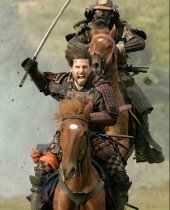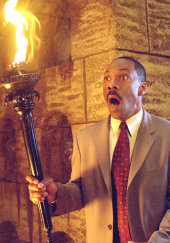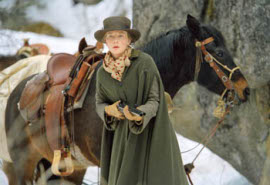 THE LAST SAMURAI
THE LAST SAMURAI
Occasionally, all it takes is sharp cinematography to get critics all woozy. How else to explain the positive notices for Edward Zwick's The Last Samurai, a period epic so unexceptional and derivative it might as well have been called Dances with Wolves Meets Braveheart? (Barkeep! Oscars for all!)
Tom Cruise plays a Civil War veteran sent to instruct Japanese armies in the ways of Western battle; after being captured by rebel forces, however, he becomes enamored with the ways of Japanese life, friendship, and war. The film, in short order, becomes Dances in Kimonos, with Tom scribbling in his notebook about the funny customs of these unusual people he'll grow to respect, Tom falling for a pretty native girl (Stands with a Sake!), Tom, with sweetly earnest incompetence, doing his damnedest to morph into a samurai, and the whole experience would be laughable if (a) apart from the battle scenes, the film weren't so deathly boring, and (b) if the movie weren't photographed so beautifully. Cinematographer John Toll has been justly rewarded for Legends of the Fall and Braveheart, and his work is often stunning, yet hiring him is sine qua non in a movie of this ilk; it's all lovely, to be sure (even the violence achieves a kind of gory grandeur), but there are no memorable images, and, considering its patchy script and sketchy characters, nothing in the film resonates beyond its surface prettiness. (Even the terrific Ken Watanabe, as Cruise's mentor, winds up as little more than Mr. Miyagi to Cruise's Ralph Macchio.) With Tom Cruise, his long locks flying, at the center of this gorgeous, hollow epic, The Last Samurai is like the ultimate crossover of National Geographic and People magazines - ideally, it should be viewed in a dentist's office.
 TIMELINE
TIMELINE
You wouldn't think that Richard Donner's science-fiction muddle Timeline would have much in common with The Last Samurai, but their two finest characteristics, surprisingly, are shared ones: Both films momentarily come to life when the onscreen armed forces begin attacking their enemies with bows and arrows, and both are fortunate enough to feature the brusquely entertaining Scottish comic Billy Connolly in a supporting role. (And Timeline makes better use of Connolly's presence.) Here, he plays a modern-day archaeologist who is mysteriously transported to 14th Century France; a group of Connolly's students are sent back in time to retrieve him, but considering that one of them is played by the thick-as-a-brick Paul Walker - cast as the Scot's son (!) - you feel like sending Connolly a personal message saying, "Don't get your hopes up." The movie opens pleasantly enough, with relaxed joshing and an easy rhythm, and Gerard Butler, who almost single-handedly wipes Walker off the screen, is pretty great in action-hero mode; I'm looking forward to seeing him in a work that deserves him. Yet there's no denying that Timeline is a dreary amalgam of many much better sci-fi-slash-medieval movies, alternately ridiculous and just plain dull, and Donner directs the proceedings listlessly (maybe because several of the works Timeline rips off, notably Ladyhawke and The Goonies, are films he himself directed). With the exception of Frances O'Connor's outrageously shrill performance - you long for someone to tie a gag around her mouth - nothing about Timeline is out-and-out awful, but viewing it actually feels like experiencing time-travel - back to the early '80s, when you saw this movie the first time around.
 THE HAUNTED MANSION
THE HAUNTED MANSION
People occasionally ask why I'm so hard on harmless "family" movies, and I usually try to explain that there's a world of difference between a film that can truly be enjoyed by all ages and one that's merely devoid of anything that anyone might find offensive. Finding Nemo, for instance, is a thrillingly good family picture because it speaks to different ages in different ways: Both adults and kids enjoy the film's animation and humor, of course, but its central themes of loss and learning to let go of your kids are aimed squarely at the parents in the audience; the ideal family movie is one that either children or adults can enjoy without the other age group serving as chaperones. Which brings us to Disney's The Haunted Mansion. Though very young kids might be enthralled by the floating CGI effects and phony art direction, I can't imagine what any rational adult could possibly get from it. With the exception of the brief warblings from a barbershop quartet of tombstone heads (admittedly, they made me chuckle), there's nothing remotely funny or clever or - perish the thought - scary during the whole course of the movie; it's a film you drop the toddlers off at while you catch Bad Santa. If you're looking for a way to get rid of the kids while you do 90 minutes worth of holiday-shopping - or if, for your own perverse reasons, you enjoy watching the continual downward trajectory of Eddie Murphy's career - I guess you could do worse than The Haunted Mansion, but it's more anesthetic than entertainment, a film that the entire family can nap through.
 THE MISSING
THE MISSING
The first title card you see during The Missing's closing credits is "Directed by Ron Howard," yet I'm not sure it's necessary - after 140 minutes, you couldn't mistake this period western for the work of anyone else. Ron Howard really is something. In picture after picture, he leapfrogs from one genre to another without ever losing his sitcom-honed sense of pacifism; every movie he directs - even "darker" works like Ransom and A Beautiful Mind - carries with it an almost unnerving sense that, as in all sitcoms, everything will wind up hunky-dory in the end, even if nothing that happens in the film should lead you to that conclusion. The Missing, for instance, features several ugly, hostile sequences - the film concerns a teenaged girl (Evan Rachel Wood), kidnapped by evil Apaches, whose mother (Cate Blanchett) and grandfather (Tommy Lee Jones) embark on her rescue - and a fair degree of dramatic tension. But the film's attempts at toughness are continually undone by Howard's ability (I hesitate to call it a talent) to keep an audience from ever becoming really uncomfortable; he's like the director as censor, shielding us from themes and images we might find too disturbing. I am in no way suggesting that the kidnapped girl's trauma be more harrowing - the film certainly doesn't require suggestions of rape - but really, wouldn't The Missing work far better without all of Ron Howard's feel-good trademarks: the jokey banter, à la Ransom, among the kidnappers; the grudging reunion between Jones and Blanchett; the too-practiced, fraudulent acting of Blanchett's youngest daughter; the requisite Clint Howard cameo? Ron Howard, God love him, is an entertainer - nothing wrong with that - but it's probably time to stop hoping he'll ever be an artist.










